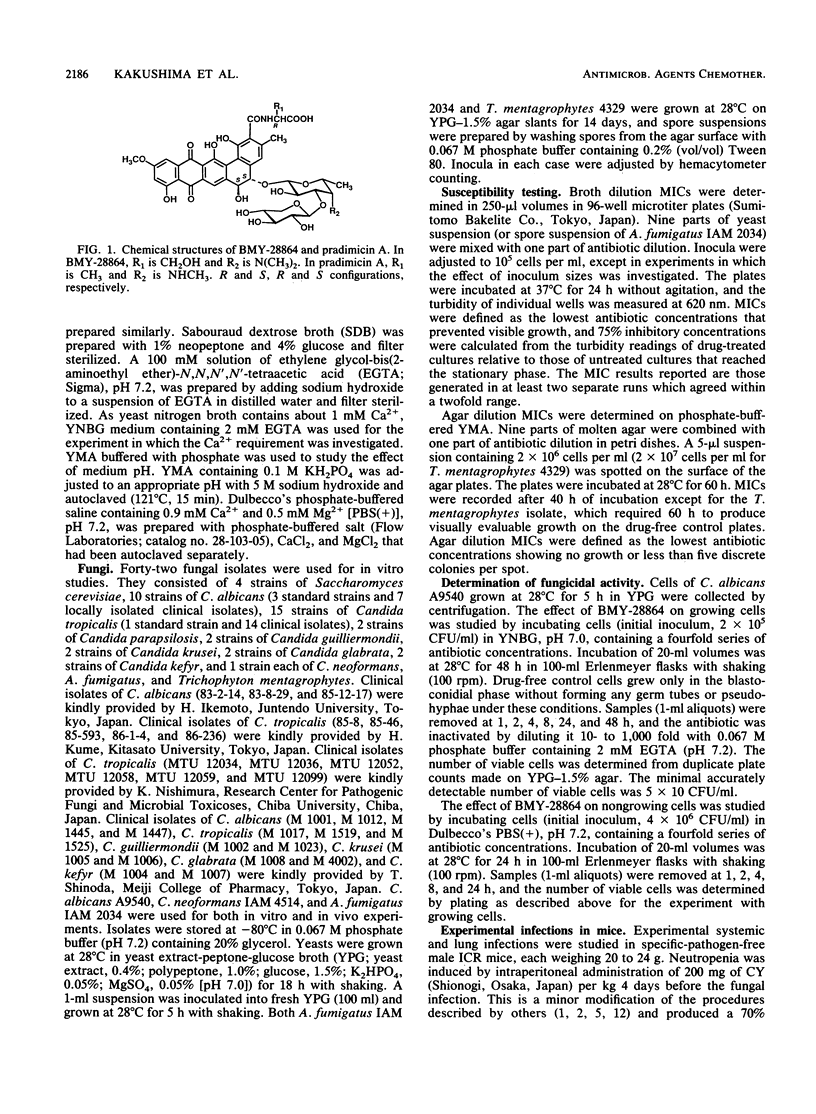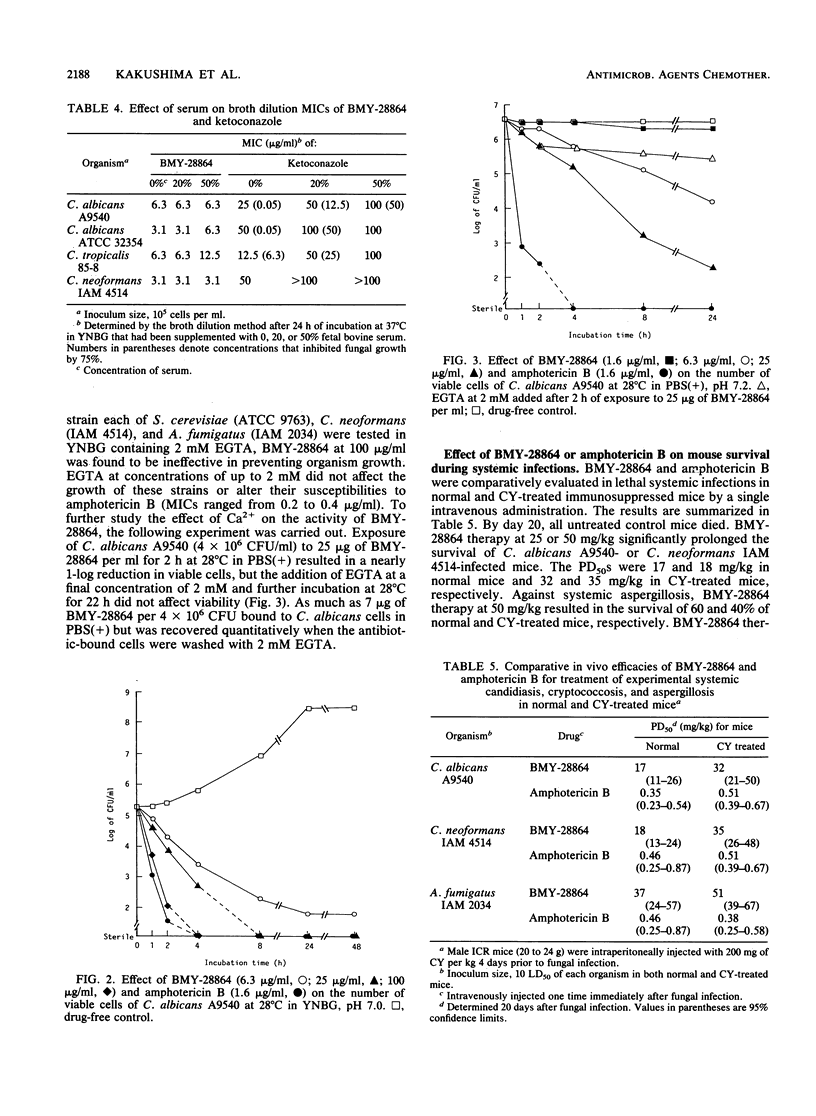Abstract
BMY-28864, a water-soluble pradimicin derivative, had potent in vitro activity against a wide variety of fungi, including those associated with deep-seated mycosis; it inhibited the growth of standard strains and clinical isolates at concentrations of 12.5 micrograms/ml or less. At the MIC or higher concentrations, BMY-28864 was fungicidal for Candida albicans under both growing and nongrowing conditions. BMY-28864 expressed fungicidal activity only in the presence of Ca2+, and its activity was totally diminished when ethylene glycol-bis(2-aminoethyl ether)-N,N,N',N'-tetraacetic acid (EGTA), a Ca2+ chelator, was added to the test medium. The effectiveness of intravenously administered BMY-28864 in vivo was examined and compared with that of amphotericin B in mouse models of fungal infections. Both normal and cyclophosphamide-treated immunosuppressed mice infected with C. albicans, Cryptococcus neoformans, or Aspergillus fumigatus responded to therapy with BMY-28864 (50% protective doses of 17, 18, and 37 mg/kg of body weight in normal mice and of 32, 35, and 51 mg/kg in cyclophosphamide-treated mice, respectively). Lethal lung infections were also established with C. albicans or A. fumigatus in cyclophosphamide-treated mice. The 50% protective doses of BMY-28864 were 15 and 23 mg/kg per dose against C. albicans and A. fumigatus, respectively. The immunosuppression induced by intraperitoneal administration of 200 mg of cyclophosphamide per kg lasted for 5 days, and total recovery was observed by day 7.
Full text
PDF





Selected References
These references are in PubMed. This may not be the complete list of references from this article.
- Bistoni F., Baccarini M., Blasi E., Marconi P., Puccetti P., Garaci E. Correlation between in vivo and in vitro studies of modulation of resistance to experimental Candida albicans infection by cyclophosphamide in mice. Infect Immun. 1983 Apr;40(1):46–55. doi: 10.1128/iai.40.1.46-55.1983. [DOI] [PMC free article] [PubMed] [Google Scholar]
- De Bernardis F., Palliola E., Lorenzini R., Antonucci G. Evaluation of the experimental pathogenicity of some Cryptococcus species in normal and cyclophosphamide-immunodepressed mice. Microbiol Immunol. 1987;31(5):449–460. doi: 10.1111/j.1348-0421.1987.tb03107.x. [DOI] [PubMed] [Google Scholar]
- Hidore M. R., Murphy J. W. Correlation of natural killer cell activity and clearance of Cryptococcus neoformans from mice after adoptive transfer of splenic nylon wool-nonadherent cells. Infect Immun. 1986 Feb;51(2):547–555. doi: 10.1128/iai.51.2.547-555.1986. [DOI] [PMC free article] [PubMed] [Google Scholar]
- Kakushima M., Nishio M., Numata K., Konishi M., Oki T. Effect of stereochemistry at the C-17 position on the antifungal activity of pradimicin A. J Antibiot (Tokyo) 1990 Aug;43(8):1028–1030. doi: 10.7164/antibiotics.43.1028. [DOI] [PubMed] [Google Scholar]
- McIntyre K. A., Galgiani J. N. In vitro susceptibilities of yeasts to a new antifungal triazole, SCH 39304: effects of test conditions and relation to in vivo efficacy. Antimicrob Agents Chemother. 1989 Jul;33(7):1095–1100. doi: 10.1128/aac.33.7.1095. [DOI] [PMC free article] [PubMed] [Google Scholar]
- Minagawa H., Kitaura K., Nakamizo N. Effects of pH on the activity of ketoconazole against Candida albicans. Antimicrob Agents Chemother. 1983 Jan;23(1):105–107. doi: 10.1128/aac.23.1.105. [DOI] [PMC free article] [PubMed] [Google Scholar]
- Moser S. A., Domer J. E. Effects of cyclophosphamide on murine candidiasis. Infect Immun. 1980 Feb;27(2):376–386. doi: 10.1128/iai.27.2.376-386.1980. [DOI] [PMC free article] [PubMed] [Google Scholar]
- Oki T., Kakushima M., Nishio M., Kamei H., Hirano M., Sawada Y., Konishi M. Water-soluble pradimicin derivatives, synthesis and antifungal evaluation of N,N-dimethyl pradimicins. J Antibiot (Tokyo) 1990 Oct;43(10):1230–1235. doi: 10.7164/antibiotics.43.1230. [DOI] [PubMed] [Google Scholar]
- Oki T., Konishi M., Tomatsu K., Tomita K., Saitoh K., Tsunakawa M., Nishio M., Miyaki T., Kawaguchi H. Pradimicin, a novel class of potent antifungal antibiotics. J Antibiot (Tokyo) 1988 Nov;41(11):1701–1704. doi: 10.7164/antibiotics.41.1701. [DOI] [PubMed] [Google Scholar]
- Oki T., Saitoh K., Tomatsu K., Tomita K., Konishi M., Kawaguchi H. Novel antifungal antibiotic BMY-28567. Structural study and biological activities. Ann N Y Acad Sci. 1988;544:184–187. doi: 10.1111/j.1749-6632.1988.tb40402.x. [DOI] [PubMed] [Google Scholar]
- Oki T., Tenmyo O., Hirano M., Tomatsu K., Kamei H. Pradimicins A, B and C: new antifungal antibiotics. II. In vitro and in vivo biological activities. J Antibiot (Tokyo) 1990 Jul;43(7):763–770. doi: 10.7164/antibiotics.43.763. [DOI] [PubMed] [Google Scholar]
- Rogers T. E., Galgiani J. N. Activity of fluconazole (UK 49,858) and ketoconazole against Candida albicans in vitro and in vivo. Antimicrob Agents Chemother. 1986 Sep;30(3):418–422. doi: 10.1128/aac.30.3.418. [DOI] [PMC free article] [PubMed] [Google Scholar]
- Sawada Y., Hatori M., Yamamoto H., Nishio M., Miyaki T., Oki T. New antifungal antibiotics pradimicins FA-1 and FA-2: D-serine analogs of pradimicins A and C. J Antibiot (Tokyo) 1990 Oct;43(10):1223–1229. doi: 10.7164/antibiotics.43.1223. [DOI] [PubMed] [Google Scholar]
- Sawada Y., Murakami T., Ueki T., Fukagawa Y., Oki T. Mannan-mediated anticandidal activity of BMY-28864, a new water-soluble pradimicin derivative. J Antibiot (Tokyo) 1991 Jan;44(1):119–121. doi: 10.7164/antibiotics.44.119. [DOI] [PubMed] [Google Scholar]
- Sawada Y., Nishio M., Yamamoto H., Hatori M., Miyaki T., Konishi M., Oki T. New antifungal antibiotics, pradimicins D and E. Glycine analogs of pradimicins A and C. J Antibiot (Tokyo) 1990 Jul;43(7):771–777. doi: 10.7164/antibiotics.43.771. [DOI] [PubMed] [Google Scholar]
- Sawada Y., Numata K., Murakami T., Tanimichi H., Yamamoto S., Oki T. Calcium-dependent anticandidal action of pradimicin A. J Antibiot (Tokyo) 1990 Jun;43(6):715–721. doi: 10.7164/antibiotics.43.715. [DOI] [PubMed] [Google Scholar]
- Tomita K., Nishio M., Saitoh K., Yamamoto H., Hoshino Y., Ohkuma H., Konishi M., Miyaki T., Oki T. Pradimicins A, B and C: new antifungal antibiotics. I. Taxonomy, production, isolation and physico-chemical properties. J Antibiot (Tokyo) 1990 Jul;43(7):755–762. doi: 10.7164/antibiotics.43.755. [DOI] [PubMed] [Google Scholar]


